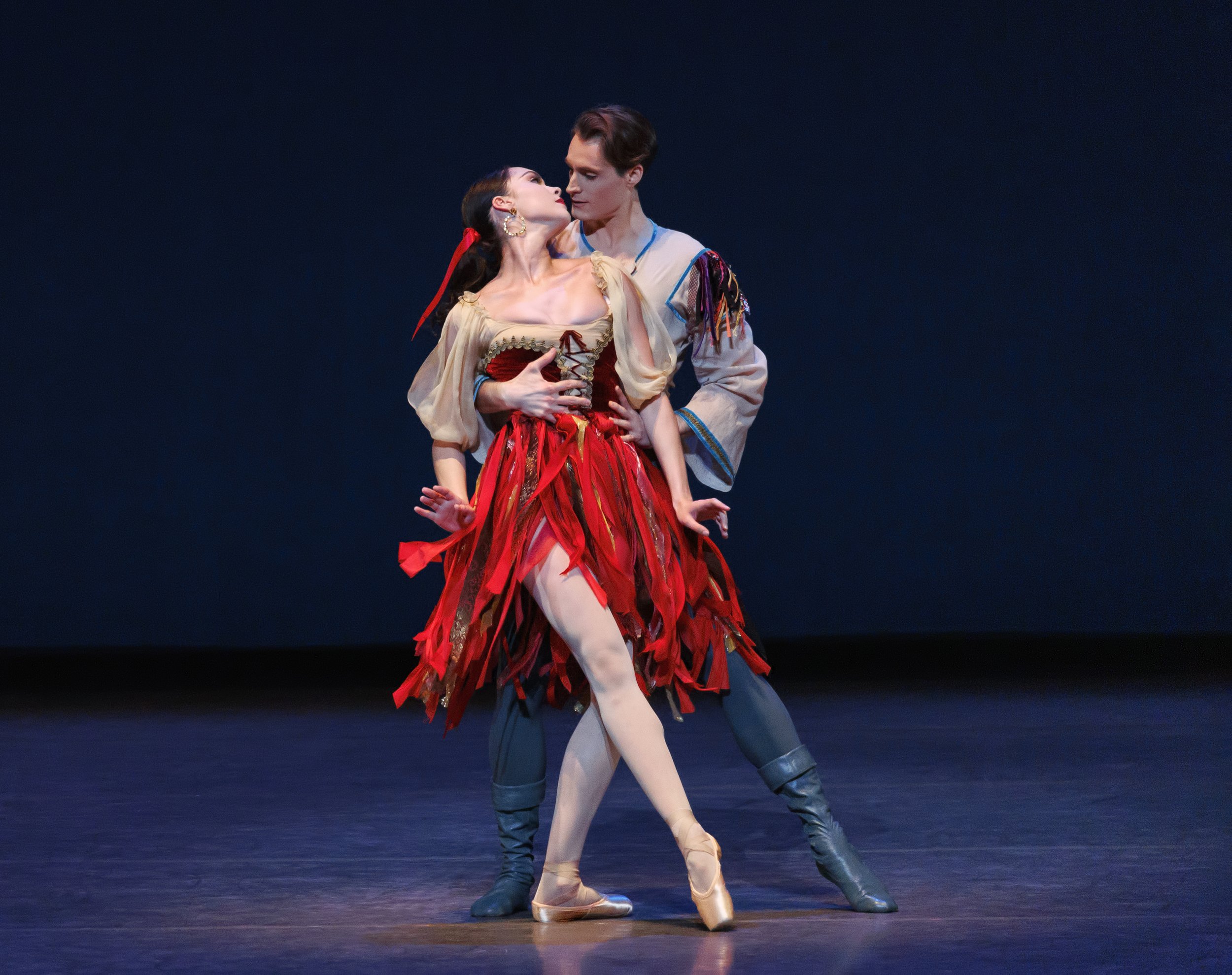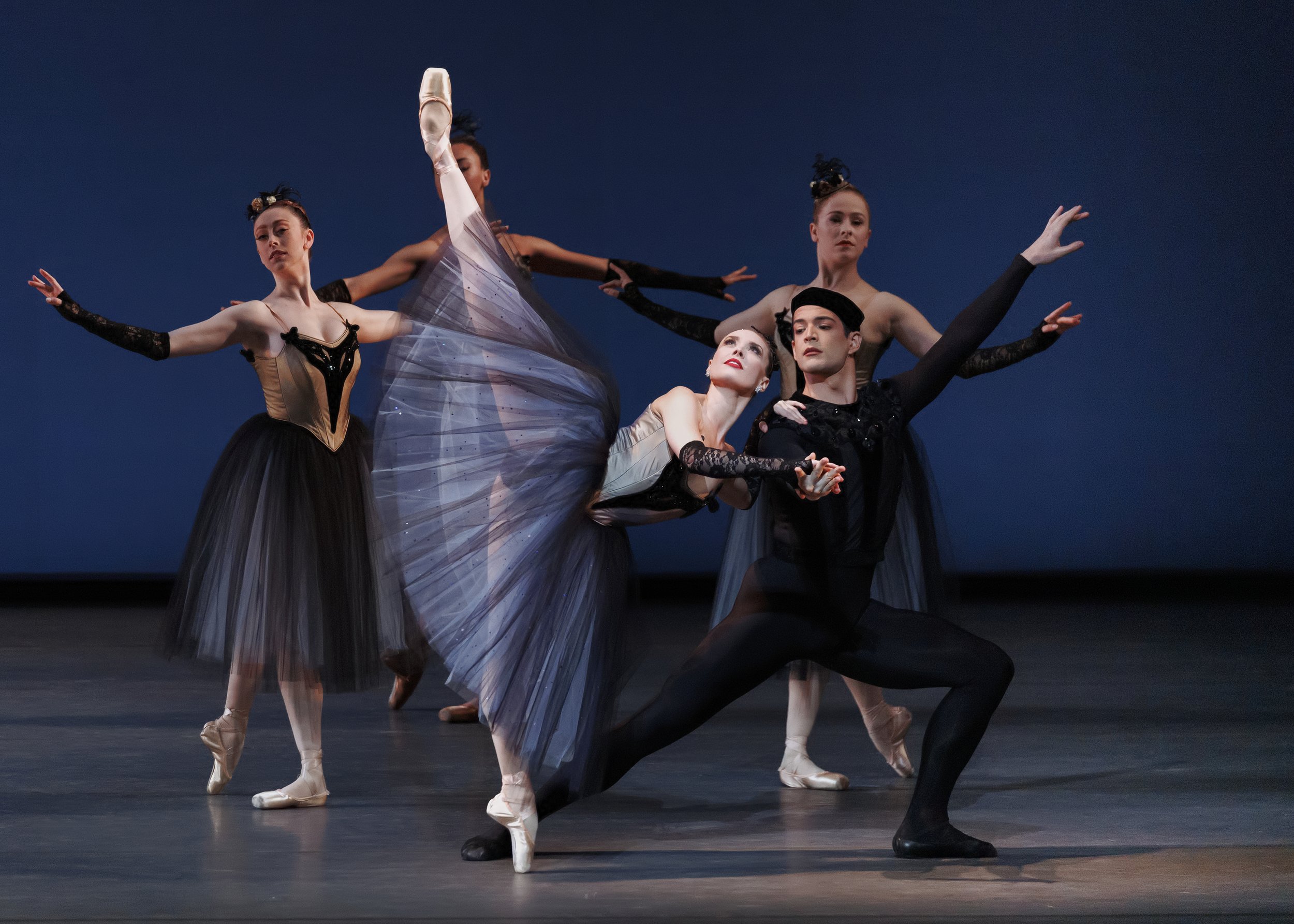NYC Ballet 2024: All Balanchine
Emilie Gerrity, Gilbert Bolden III and the Company in George Balanchine’s Bourrée Fantasque. Photo credit: Erin Baiano.
On April 23, 2024, New York City Ballet opened the Spring ‘24 season with their “All Balanchine” program, comprised of four works from the revered choreographer set to the music of French composers. Leading the NYC Ballet Orchestra that night was Andrew Litton.
Opening the program was “Bourree Fantasque.” Set to pieces composed by Chabrier, this work was created by Balanchine for NYCB and premiered on December 1, 1949. The work itself pays lighthearted but touching tribute to classical dance while featuring moments of more-modern dances such as can-can and tango, creating a work that fascinates over the course of its movements while bearing a fresh, American charm throughout.
After the overture of vibrant fanfare and drums from the “Marche Joyeuse,” the curtain opened and officially began as the ensemble of lined-up dancers strode onstage and split into pairings. As the women stepped backwards into position, one briefly slipped while pushing herself off the ground, but fortunately caught herself and recovered well. The soloists of this movement were Emily Kikta and KJ Takahashi, whose respective strengths played well into the comedic aspects required of the duo where a woman is paired with a notably shorter man. After exchanging some flirtatious footwork, they consistently drew laughs through small touches such as the brief conversation when Kikta floats down to kneel on Takahashi’s crouched lap as the strings take on a more romantic hue, as well as the quick ducks of his head as the working leg of Kikta’s supported arabesque rotated over his shoulder as if on an elegant collision course. Of the four Chabrier works used within the ballet, this opening movement is the one which actually features the music of his “Bourree Fantasque,” and the upbeat quality of the eponymous French dance pervaded much of the choreography through quick and lighthearted steps.
The second movement, featuring the prelude from Chabrier’s 1886 opera, Gwendoline, opened to a notably more tranquil atmosphere from the winds. Two lines of dancers entered to frame the center of the stage before the lead pair each raised a backwards leg, as if raising the curtain on the romantic scene contained within as the soloists entered through opposing sides. Originally slated for this movement was Isabella LaFreniere and Chun Wai Chan, but covering that evening was Emilie Gerrity and Gilbert Bolden III. After finding one another among the corps, the latter melts into place as the soloists share a private moment before Gerrity leads Bolden to center stage with a series of demurring arabesques. This movement emphasized a far gentler quality, as seen by the delicacy of the lifts as Bolden whisks her across the stage and back, even while Gerrity is linked by the hands to two of the ensemble in later phrases. As the corps fixed themselves once more, the soloists had a moment to better explore the private moment from earlier as the theme swelled to poignant heights under Litton’s baton. The two part from their embrace, with Gerrity skimming offstage and leaving Bolden to search his way off much the same way as he began, as the rest of the dancers slowly disassembled the scene to close.
Victor Abreu and Alexa Maxwell in George Balanchine’s Bourrée Fantasque. Photo credit: Erin Baiano.
Last in this selection was the “Fête Polonaise” from Chabrier’s 1887 opera “Le Roi Malgré Lui.” This finale started with a jovial energy as the corps engaged in high lifts and tights rings to introduce soloists Alexa Maxwell and Victor Abreu. Together they dazzled and took the lifts to greater heights as he momentarily balanced her waist on his open palm. While they carried the movement with much energy and charm, one instance of Maxwell's backwards leap into a low dive was blunted by what felt like a late catch, but the move itself was executed with such little telegraphing that the tricky window of opportunity is understandable. This, and the initial slip in the first movement, were the only bumps in an otherwise enchanting performance. The corps built as dancers from the earlier movements rejoined the stage and a grand scene soon followed as they formed three rings around the soloists in the center; their festive circling and upbeat chords from the orchestra unfolded with carnival-like exuberance which drove the work to a splendid close.
Next on the program was "The Steadfast Tin Soldier”. Based on the Hans Christian Andersen story of the same name, and set to music from Bizet's "Jeux d'Enfants," this brief yet charming pas de deux was broken into four sections. Portraying the Tin Soldier was Anthony Huxley, whose straight-limbed bearing and linear motions finely conveyed the stiff yet expressive toy as he marched his way about the stage punctuated by spun leaps and other militaristic touches. Opposite him was Erica Pereira as the ballerina doll. Her dainty poise and energy, bordering on fragility, nicely contrasted the Tin Soldier through her pirouettes and occasional bouts of dizziness. After each toy has their moment to display their qualities, their union carried with an undeniable sweetness as the two brought the best out of each other, with cute touches such as the way the soldier's arms and legs pop out diagonally as he tries to position himself to catch his partner, or how the ballerinas manually turns the soldier's head to avert his bashful gaze from the floor.
Erica Pereira and Anthony Huxley in George Balanchine’s The Steadfast Tin Soldier. Photo credit: Erin Baiano.
The last section is a sudden celebration as the two broke into spirited leaps and turns, as if unable to contain their excitement. True to classic fairy tale form, a sad ending ensues as the ballerina is blown into the fireplace by the gust from the opened door, with Pereira's series of spins suggesting a scattered battering of winds rather than a single fateful breeze as she fought to little avail. As the Tin Soldier reclaims his heart from the cinders, Huxley's crushed demeanor was clear despite his dutiful march back into his starting position at the head of the ranks. Of the works making up this program, this was a bittersweet reprieve from the exuberance of the other selections.
Following a brief pause, the program continued with "Errante," Balanchine's 1975 ballet widely known under its original title of "Tzigane" and set to the eponymous violin piece by Ravel. This reworking had great input and supervision from renowned dancer Suzanne Farrell, who premiered the soloist role, and for whom Balanchine originally choreographed the piece. While previous stagings have set the work in a minimalistic atmosphere of little more than bare trees and moonlight, this presentation takes it even further and removes all background and sense of setting, casting our whole attention on the soloist and following dancers.


Mira Nadon and Aarón Sanz in George Balanchine’s Errante. Photo credit: Erin Baiano.
The first half of the roughly 10-minute work is an extended showcase of allure and elegance as the female soloist is in passionate conversation with the violin, played by Kurt Nikkanen to intoxicating effect. Mira Nadon made the most of her time in the spotlight, with every gesture charged with a romantic flair that captivated attention. When Aaron Sanz enters the stage, he mimics the sway of her movements as he draws nearer until she notices him and they begin in earnest. He gave the sense of being her shadow at some moments and her partner at others through their sense of chemistry and shared technique.
The third section is a spirited ensemble as the corps joins the soloists while the orchestra builds to an exhilarating tempo. Despite the abundance of passion contained within, the piece itself closes out with a snappy, mirthful cadence as the dancers pivot to a quick tableaux of the men giving reverence to their partners with brisk smiles and open arms.
Megan Fairchild, Joseph Gordon and the Company in George Balanchine’s Symphony in C. Photo credit: Erin Baiano.
Last on the program of French works was Bizet’s “Symphony in C,” an energetic work which builds to stunning heights across its four movements. The opening “Allegro Vivo” carried with sufficient verve as the two flanking lines of dancers mingled and conversed, with highly synchronized port de bras, before introducing soloist Megan Fairchild. Her brief solo featured gently-turning arabesques round the stage before the corps joined her lead. They’re soon joined by two male dancers and soloist Joseph Gordon, who supported Fairchild in some deft turns and retreating jetes before his brief solo saw him engage in a series of slow but powerful spins which illustrated both great control as well as ability to generate momentum, earning a quick round of applause before all dancers rejoined and led to a quick close.
The second movement, “Adagio,” was driven by the almost plaintive winds as the line of women was passed over by the joined hands of the two couples skimming the opposite way across the stage. Principals Sara Mearns and Tyler Angle demonstrated some truly gentle partnering as he floated her back and forth, as well as some lengthier carried across the stage with her foot landing in the space made by the linked hands of the other couples. This only continued as the corps melted away, leaving them to a lovely duet featuring a series of deep cambres, turns, and forward bends against the rising string theme.
The “Allegro Vivace” of the third movement carried with nearly constant, controlled leaps from the corps and principals Emma Von Enck and Roman Mejia. The two were in sharp sync as they alternated between shared movements and supported turns and bends. The corps also shone through some nicely executed linework and passing figures while the principals wove on and off stage. The closing movement, also “Allegro Vivace,” was opened swiftly over the running strings as two groups of women joined principals Alston MacGill, covering that night for Emilie Gerrity, and Harrison Coll. A dazzling scene soon unfolded as the corps built to a tremendous presence over the course of the movement; as groups after group joined the stage their numbers either in motion or powerfully flanking the highlighted dancers during their measures. The Swarovski elements of their costumes added a glittering veneer to the slightest movements, and made the unity of the corps all the more pronounced as they worked to a joyous and powerful conclusion.
Emma Von Enck, Roman Mejia and the Company in George Balanchine’s Symphony in C. Photo credit: Erin Baiano.
The program of French works had much to enjoy, with two spirited and celebratory works bringing up the ends, and two shorter pas de deux in the middle which contained no shortage of lighthearted charm and romantic enchantment, respectively. Overall the performance made for a splendid opening to the Spring’ 24 season, which is set to continue with their “Masters at Work” program featuring Robbins’ “Dances at a Gathering,” and Balanchine’s “Brahms-Schoenberg Quartet.”
- written by Logan Martell






